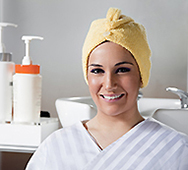Motivated by a strong aesthetic and hedonistic culture emphasizing personal appearance and grooming, Brazil’s professional hair care market remained luxuriant and full of bounce through 2011. Although growth slightly declined over the aberrant 2010 figures, the 2011 market overall still grew nearly 8% to register a compelling BRL 750 million in sales.
The Brazilian consumer, emboldened by economic stability and rising living standards, has been encouraged by practical and enticing new products often combining several functionalities, such as coloring and straightening as offered by Procter & Gamble’s Clairol Professional Alisamento com Cor (“Straightening with Color”).
Although hair coloring products remain the largest category on the professional hair care market in Brazil, hair styling products continued to stand out, attracting an astonishing near 40% increase in sales over the previous year. While hair styling products focused on multifunctional offerings to complement the hair treatment process, hair coloring registered an increasing inflow of new products featuring less harmful ingredients. Mirroring a global tendency, the “naturals” trend is slowly becoming an important trend in Brazil. Hair straightening and perming products continue to fall out of favor as awareness of the potential harmful effects of their principal ingredients grows. A consequence of this has been marketers repositioning and re-categorizing many of their straightening products and launching new ones (conditioners, shampoos, and styling products) with straightening benefits. Marketers are also seeking new opportunities in the underexplored styling category, as more concerned consumers shift from damaging straightening products to less harmful and more natural finishing products which promise similar results.
As a consequence of concerted efforts made by salons and marketers to target neglected or underdeveloped demographics such as the men, teenager and senior consumer segments, men in particular are increasingly addressing their appearance and seeking to maintain a youthful countenance. The result is that not only are men visiting hair salons more frequently for hair services, but they are also availing themselves of a variety of other services and treatments offered by professionals, such as skin treatments, pedicures, massages, and manicures.
Brazil’s top 10 marketers account for almost 80% of the market, and the remaining are numerous smaller players focused on low-cost mass brands. L’Oréal claims approximately 34% of the total market share with its long-established and well-regarded brands, especially L’Oréal Professionnel and Kérastase, while the second largest player, Procter & Gamble, follows with its top selling Wella brand portfolio.
Just published, the Brazilian volume of Kline’s Salon Hair Care Global Series: Market Analysis and Opportunities, provides subscribers with a comprehensive high-value analysis of the professional hair care market, focusing on market size and growth, key changes, challenges, and business opportunities.
Author:
Agnieszka Saintemarie, Project Manager

